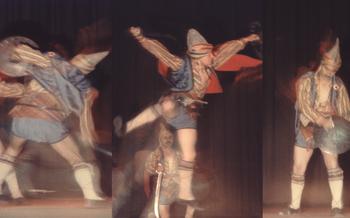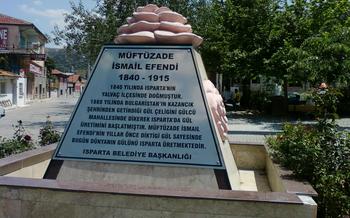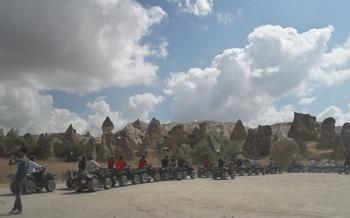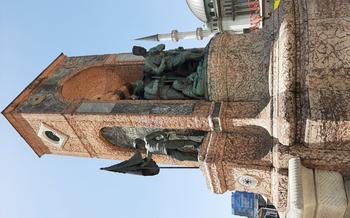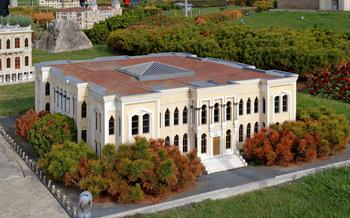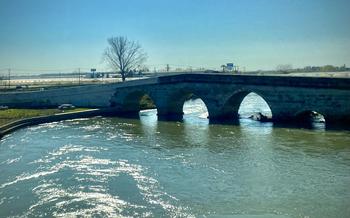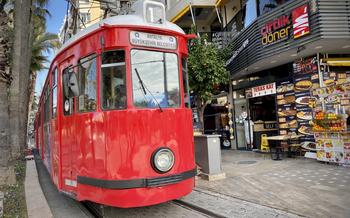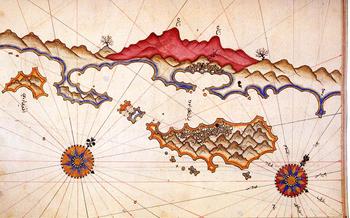
Ottoman Cemetery
- Unveiling the History of Kalkan: A Journey through the Ottoman Cemetery
- Location and Accessibility
- Architectural Features
- Historical Figures and Notable Burials
- Epitaphs and Inscriptions
- Cultural Significance
- Restoration and Preservation
- Local Traditions and Customs
- Photography and Videography
- Visiting Hours and Etiquette
- Nearby Attractions
- Food and Refreshments
- Accommodations
- Transportation
- Insider Tip:
Unveiling the History of Kalkan: A Journey through the Ottoman Cemetery
In the heart of the picturesque town of Kalkan, nestled amidst the turquoise waters of the Mediterranean Sea and the majestic Taurus Mountains, lies a historical treasure that speaks volumes about the town's rich past - the Ottoman Cemetery. This ancient burial ground, dating back to the Ottoman period, offers a glimpse into the town's evolution over the centuries and its deep-rooted connection with the Ottoman Empire, which ruled over Anatolia for more than six centuries.
The Ottoman Cemetery stands as a testament to the town's significance during the Ottoman era. Its origins can be traced back to the 16th century when Kalkan emerged as a vital port town and trading hub. As the town flourished under Ottoman rule, the cemetery became a sacred space for the burial of prominent figures, religious leaders, and ordinary citizens who contributed to Kalkan's growth and prosperity.
Ottoman cemeteries hold a profound significance in Turkish culture and history, serving as repositories of the nation's collective memory. They are not merely burial grounds but also places of reverence, remembrance, and connection with the past. The Ottoman Cemetery in Kalkan is a microcosm of this rich cultural heritage, embodying the town's unique identity and its deep respect for its ancestors.
Preserving and respecting cultural heritage sites like the Ottoman Cemetery is of utmost importance. These sites are not just historical relics but living testaments to the past that continue to shape the present. By safeguarding and maintaining such sites, we honor the legacy of our forebears and ensure that future generations can appreciate and learn from our shared history.
Location and Accessibility
The Ottoman Cemetery occupies a serene location within the heart of Kalkan, a picturesque town nestled along the Turquoise Coast of Turkey. Easily accessible on foot, the cemetery lies just a short stroll from the town center, inviting visitors to delve into its intriguing history. For those arriving by car, ample parking spaces are available nearby, ensuring a hassle-free visit. Additionally, the cemetery is conveniently serviced by public transportation, with several bus stops located within walking distance, making it accessible to travelers from all corners of Kalkan. To enhance your journey, a detailed map or directions to the cemetery can be obtained from the local tourism office or online resources.
Architectural Features
The Ottoman Cemetery in Kalkan stands as a testament to the town's rich history and cultural heritage. Its unique architectural features and design elements reflect the artistic and spiritual traditions of the Ottoman Empire.
The cemetery is characterized by its traditional Ottoman-style tombstones, each adorned with intricate carvings and inscriptions. These tombstones vary in size and shape, ranging from simple headstones to elaborate mausoleums. They often feature decorative motifs such as floral patterns, geometric designs, and calligraphy, which add a touch of elegance and symbolism to the cemetery.
Within the cemetery, visitors can find a variety of architectural landmarks that showcase the Ottoman architectural style. These include elaborate fountains, which provided water for ablutions and purification rituals, as well as prayer areas and mausoleums for prominent figures. The cemetery also features a number of cypress trees, which are commonly found in Islamic cemeteries and symbolize eternity and remembrance.
The architectural elements of the Ottoman Cemetery hold significant symbolic meaning in Islamic culture. The use of tombstones and inscriptions represents the belief in the afterlife and the importance of honoring the deceased. The decorative motifs and calligraphy often carry spiritual messages or verses from the Quran, reflecting the religious beliefs and traditions of the Ottoman people.
Exploring the architectural features of the Ottoman Cemetery provides a deeper understanding of Ottoman history, culture, and religious beliefs. Visitors can appreciate the intricate craftsmanship and symbolism embedded in each tombstone and structure, gaining a glimpse into the lives and legacies of those buried within.
Historical Figures and Notable Burials
The Ottoman Cemetery in Kalkan is the final resting place of several prominent historical figures and notable individuals who played a significant role in Turkish history, culture, and society. Among them is Mehmet Pasha, a renowned Ottoman governor who served during the 16th century. He was known for his military prowess and his contributions to the expansion of the Ottoman Empire. His elaborate mausoleum is a testament to his status and the respect he commanded.
Another notable figure buried in the cemetery is Hacı Mustafa Efendi, a revered scholar and religious leader who lived during the 17th century. He was renowned for his knowledge of Islamic law and his dedication to teaching and guiding his community. His tomb is a place of pilgrimage for many who seek blessings and inspiration.
The cemetery is also home to the graves of several local poets, artists, and musicians who left an indelible mark on Kalkan's cultural heritage. Their contributions to literature, art, and music are fondly remembered and celebrated by the town's residents.
Visiting the graves of these historical figures and notable individuals provides a glimpse into the rich history and cultural tapestry of Kalkan. Their stories and achievements serve as a reminder of the town's deep-rooted traditions and the contributions of its people to Turkish society.
Epitaphs and Inscriptions
The Ottoman Cemetery in Kalkan is a treasure trove of epitaphs and inscriptions that offer a glimpse into the lives and beliefs of those buried there. The tombstones bear a variety of inscriptions, ranging from simple names and dates to elaborate verses and poems. The epitaphs often express love, longing, and remembrance and provide insights into the social and cultural values of the Ottoman era. They mention the deceased's profession, family lineage, and personal qualities, highlighting their contributions to the community.
Some tombstones are adorned with intricate calligraphy, showcasing the artistic skills of the Ottoman calligraphers. The inscriptions are written in a blend of Ottoman Turkish and Arabic, reflecting the cultural and linguistic diversity of the empire. Visitors can spend hours exploring the cemetery, deciphering the inscriptions, and learning about the fascinating lives of the individuals buried there.
One particularly poignant epitaph reads: "Here lies my beloved wife, who was the light of my life. Her memory will forever live in my heart." Another inscription, written in beautiful calligraphy, states: "This world is a transient journey, but the hereafter is eternal. May Allah grant us peace and happiness in the next life."
The epitaphs and inscriptions in the Ottoman Cemetery are a testament to the rich cultural heritage of Kalkan and Turkey. They offer a unique opportunity for visitors to connect with the past and gain a deeper understanding of the lives and beliefs of the Ottoman people.
Cultural Significance
The Ottoman Cemetery holds immense cultural significance as a reflection of Turkish history, traditions, and religious beliefs. Cemeteries in Turkish culture are not merely burial grounds but sacred spaces of remembrance, respect, and connection with the past. They serve as a tangible reminder of the town's rich history and the lives of those who have passed on.
The Ottoman Cemetery is a place where the community gathers to honor and pay respects to their ancestors. During religious holidays and special occasions, families visit the cemetery to pray, recite verses from the Quran, and leave flowers on the graves of their loved ones. These visits are not only a way to remember the deceased but also to strengthen the bonds of family and community.
The cemetery also plays a role in local traditions and customs. For example, during the holy month of Ramadan, many people visit the cemetery after breaking their fast to pray for the deceased and seek forgiveness for their sins. These visits are often accompanied by the sharing of food and stories, creating a sense of unity and compassion within the community.
Restoration and Preservation
The Ottoman Cemetery, like many historical sites, faces the challenges of time and decay. Over the years, efforts have been made to restore and preserve this valuable heritage site. Local authorities, in collaboration with cultural heritage organizations, have undertaken restoration projects to repair damaged structures, clean and maintain the grounds, and document the inscriptions on the tombstones. These efforts aim to protect the cemetery's architectural integrity and ensure its preservation for future generations.
One of the main challenges in preserving the cemetery is the natural wear and tear caused by weather conditions and the passage of time. Tombstones and inscriptions can become faded or eroded, making it difficult to decipher the information they contain. To address this, restoration projects often involve cleaning and repairing the tombstones, as well as re-painting or re-carving inscriptions to ensure their legibility.
Another challenge is protecting the cemetery from vandalism and neglect. Local authorities and community members play a crucial role in safeguarding the site by monitoring its condition, reporting any incidents of damage or theft, and raising awareness about the importance of preserving the cemetery. By working together, they strive to ensure that this historical treasure remains a source of pride and remembrance for the people of Kalkan and visitors alike.
Local Traditions and Customs
Visiting the Ottoman Cemetery is not only a historical experience but also a cultural one, as it offers a glimpse into local traditions and customs surrounding death and remembrance. When visiting the cemetery, it is important to be respectful and mindful of these traditions. Visitors should dress modestly and avoid wearing shorts or revealing clothing. It is customary to remove shoes before entering the cemetery, as a sign of respect for the deceased.
In Turkish culture, it is considered disrespectful to step on or walk over graves. Visitors should always walk around the graves and avoid crossing over them. It is also considered rude to point at or touch the tombstones. Instead, visitors should use their hands to gesture or point.
When visiting the graves of loved ones, it is common for Turkish people to bring flowers or other offerings. These offerings are placed on or near the graves as a symbol of remembrance and respect. Visitors are welcome to do the same, but should be mindful not to leave any trash or debris behind.
During certain times of the year, such as religious holidays or anniversaries, the Ottoman Cemetery may be particularly busy with visitors. It is important to be patient and respectful of others, and to avoid disturbing any ceremonies or rituals that may be taking place.
By following these local traditions and customs, visitors can show their respect for the deceased and their families, and contribute to the preservation of the Ottoman Cemetery as a sacred and historical site.
Photography and Videography
When visiting the Ottoman Cemetery, it is important to be respectful of the privacy and dignity of the deceased and their families. Photography and videography are generally permitted, but it is essential to do so in a manner that does not disturb or offend others. Avoid taking photos of individuals without their consent, and be mindful of the overall atmosphere of the cemetery.
Use a telephoto lens or zoom function to capture images from a distance, ensuring that you do not intrude on anyone's personal space. If you wish to take close-up photos of specific tombstones or inscriptions, ask permission from the cemetery caretaker or a local guide.
Remember that the Ottoman Cemetery is a sacred place, and it is important to behave respectfully. Turn off the flash on your camera to avoid disturbing others, and keep your voice low. By following these guidelines, you can capture beautiful and meaningful photos while respecting the sanctity of the cemetery.
Visiting Hours and Etiquette
The Ottoman Cemetery is generally open to visitors during daylight hours, but it's always advisable to check local sources or the official website for specific visiting hours, as these may vary depending on the season or special events.
When visiting the cemetery, it's essential to be respectful and mindful of the sacred nature of the site. Visitors should dress modestly and avoid loud or disruptive behavior. Photography and videography are permitted, but it's important to be discreet and avoid disturbing others or taking photos of individuals without their consent.
Remember to tread softly and avoid walking on or near the graves. If you notice any damaged or neglected tombstones, you can report it to the local authorities or cemetery caretakers to ensure proper maintenance and preservation of the site.
By following these guidelines, visitors can show their respect for the deceased and their families while exploring the rich history and cultural heritage of the Ottoman Cemetery.
Nearby Attractions
After exploring the Ottoman Cemetery, visitors can venture into the vibrant town of Kalkan and discover its many attractions. The Kalkan Bazaar is a must-visit, offering a lively atmosphere and an array of local handicrafts, souvenirs, and traditional Turkish delights. History enthusiasts can delve deeper into the region's past at the Kalkan Museum, which showcases artifacts and exhibits from ancient civilizations that once flourished in the area.
For those seeking relaxation and rejuvenation, the Kalkan Public Beach is just a short walk away, offering crystal-clear waters, sunbathing spots, and opportunities for swimming, snorkeling, and paddleboarding. Alternatively, visitors can embark on a scenic boat tour, departing from Kalkan Harbor, and explore the stunning coastline, hidden coves, and nearby islands, such as Kekova and Kastellorizo.
To experience the authentic flavors of Turkish cuisine, visitors can head to the charming Old Town, where they will find an array of traditional restaurants, cafes, and bars serving mouthwatering dishes and refreshing beverages. Be sure to sample local specialties like meze platters, grilled seafood, and Turkish coffee.
Food and Refreshments
Your visit to the Ottoman Cemetery can be enhanced by exploring the culinary delights of Kalkan. In the vicinity of the cemetery, you'll find a range of cafes, restaurants, and markets that offer a variety of local and international cuisines. Indulge in the flavors of traditional Turkish dishes such as gözleme (stuffed flatbread) or keşkek (a hearty meat stew). Don't miss the opportunity to sample freshly caught seafood at one of the many fish restaurants along the waterfront.
For a quick bite, grab a simit (sesame-coated bread ring) from a local bakery or savor the sweetness of Turkish delight from one of the many confectionery shops. If you're looking for a more substantial meal, try the meze platters at a traditional Turkish restaurant, offering a variety of small dishes to share.
To quench your thirst, try a refreshing glass of ayran (a yogurt-based drink) or indulge in the sweet flavors of Turkish coffee. For those who prefer something stronger, there are several bars in the area where you can enjoy a cold beer or a glass of wine.
Whether you're looking for a quick snack or a leisurely meal, you'll find plenty of options to satisfy your taste buds near the Ottoman Cemetery. Embrace the opportunity to experience the culinary delights of Kalkan and make your visit even more memorable.
Accommodations
When planning your stay in Kalkan, you'll find a diverse range of accommodation options to suit every budget and preference. From cozy guesthouses and charming boutique hotels to luxurious resorts and private vacation rentals, there's something for every traveler.
If you're seeking a truly authentic experience, consider staying in the heart of Kalkan's old town. Here, you'll find charming guesthouses nestled amidst cobblestone streets and traditional Ottoman-style houses. These guesthouses often offer a glimpse into the town's rich history and culture, with warm hospitality and personalized service.
For those seeking a more luxurious stay, Kalkan boasts a selection of upscale hotels and resorts that offer stunning views of the Mediterranean Sea and world-class amenities. These resorts often feature private beaches, infinity pools, and gourmet restaurants, ensuring a truly indulgent experience.
No matter your budget or preferences, you're sure to find the perfect accommodation in Kalkan. Be sure to book your stay in advance, especially during the peak season, to avoid disappointment.
Transportation
Getting to and from the Ottoman Cemetery is relatively easy, with various transportation options available. For those who prefer public transportation, several bus routes stop near the cemetery, making it accessible from different parts of Kalkan. Visitors can check with local transportation authorities for specific routes and schedules. Taxis are also readily available in Kalkan, providing a convenient and direct way to reach the cemetery. For those who prefer the freedom and flexibility of self-exploration, car rental services are available in town. Renting a car allows visitors to explore the cemetery at their own pace and venture into other nearby attractions. When navigating the local transportation system, it's always a good idea to have a map or GPS device handy, as some streets in Kalkan can be narrow and winding. Additionally, it's advisable to carry small denominations of Turkish Lira for bus fares or taxi rides.
Insider Tip:
For a truly unique experience, consider visiting the Ottoman Cemetery at sunset. As the sun dips below the horizon, the cemetery takes on a magical and ethereal glow, casting long shadows across the tombstones. The atmosphere becomes serene and peaceful, inviting you to reflect on the lives of those who have passed. Take a moment to sit and soak in the tranquility of the surroundings, letting the beauty of the sunset and the history of the cemetery wash over you. It's a truly memorable experience that will stay with you long after you leave.
